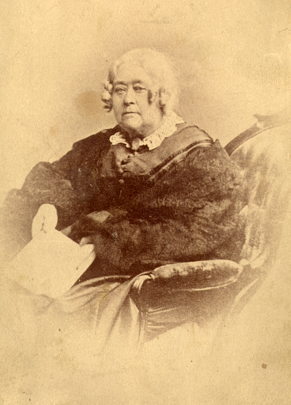 |
ELIZABETH PALMER
PEAbody
35. Cabinet card photograph of Elizabeth Palmer Peabody.
Elizabeth Palmer Peabody (1804-1894) devoted her long and full life to the expression of Transcendental idealism in a variety of forms. Greatly admired by some of her contemporaries as a model of passionate commitment, she was dismissed by others as meddlesome and absent-minded. Abolitionist minister Theodore Parker praised her as “a woman of most astonishing powers … many-sidedness and largeness of soul … rare qualities of head and heart … A good analyst of character, a free spirit, kind, generous, noble.” Margaret Fuller, on the other hand, was impatient with Peabody’s inattention to detail, and Emerson—who admired much about her—could not keep himself from commenting on her careless grooming. Novelist Henry James caricatured her mercilessly as Miss Birdseye in The Bostonians (1886). Teacher and educational reformer, founder of the kindergarten in America, abolitionist, opponent of European autocratic despotism, friend of political refugees, advocate of Native American rights and education, of woman’s suffrage, and of world peace, Peabody worked unceasingly toward the improvement of society. In the 1840s, she ran a circulating library and bookstore at 13 West Street in Boston, providing the Transcendentalists with volumes of foreign literature and philosophy. Margaret Fuller conducted some of her conversations at 13 West Street, and the Brook Farm utopian community was planned there. Moreover, Peabody was a publisher at a time when few women were involved in that business. She published Emancipation by Dr. William Ellery Channing (her mentor), several volumes by Hawthorne, two of the four volumes of The Dial, and the short-lived journal Aesthetic Papers (1849), which included the first appearance in print of Thoreau’s “Resistance to Civil Government” (“Civil Disobedience”). Peabody was also a gifted linguist, familiar with some dozen languages, and a prolific writer on education, reform, language, history, art, and other topics. Sister-in-law of Nathaniel Hawthorne, who married her sister Sophia in 1842, and of educational reformer Horace Mann, who married her sister Mary in 1843, she associated with all in Emerson’s Transcendental circle. In the late 1830s, she visited the Emersons in Concord, and later lived here during two periods of her life (with her widowed sister Mary Mann from 1859, and with her brother Nathaniel from 1878). Peabody’s most lasting impact was as a teacher and educational reformer. Sharing Bronson Alcott’s belief that education is a matter of drawing out inner knowledge (particularly moral and spiritual), she was involved in a number of innovative educational ventures, culminating in the establishment of the kindergarten in America from 1859. In 1832, she held the first of her “reading parties,” or “conferences,” for women. The sessions consisted of reading, lecture, and dialogue on a chosen topic. Margaret Fuller later applied this interactive process in her conversation series. From 1834 to 1836, Peabody served as Alcott’s assistant at the Temple School in Boston. Her Record of a School, prepared from her manuscript notes on Alcott’s dialogues with his students, was published in 1835. Alcott’s two-volume Conversations with Children on the Gospels (1836-1837) was edited by Alcott from Peabody’s notes. In the 1850s, she promoted the teaching of history through color-coded chronological grid charts introduced by Josef Bem, and lived and taught at the Raritan Bay Union in Eagleswood, New Jersey, one of the cooperative communities that sprang up in the mid-19th century. In 1859, Peabody took up the most significant educational work of her life, the promotion of early childhood education as pioneered by German educator Friedrich Froebel, who had worked with very young children and formulated an approach based on organized play, the use of the hands and the senses, and involvement with nature. Peabody established the first formally organized American kindergarten in America in 1860, and for the rest of her life worked with missionary zeal to advance the cause. In the classroom, in the Foreign Library, and in her efforts on behalf of oppressed groups and individuals, Elizabeth Peabody demonstrated determination to bring reality in line with philosophy, in essence forging an applied version of Emerson’s Transcendentalism. Although he did not take Elizabeth Peabody as seriously as he did Margaret Fuller, Emerson nevertheless recognized her intellectual gifts. He wrote of her in one of his notebooks: “A wonderful literary head, with extraordinary rapidity of association, and a methodising faculty which enabled her to weave surprising theories very fast, & very finely, from slight materials. Of another sex, she would have been a first-rate academician; and, as it was, she had the ease & scope & authority of a learned professor or high literary celebrity in her talk. I told her I thought she ought to live a thousand years, her schemes of study & the necessities of reading which her inquiries implied, required so much.”
No image in this online display may be reproduced in any form, including electronic, without permission from the Curator of Special Collections of the Concord Free Public Library.
Next Entry - Previous Entry - Back to Section IV Contents Listing - Back to Exhibition Introduction - Back to Exhibition Table of Contents |